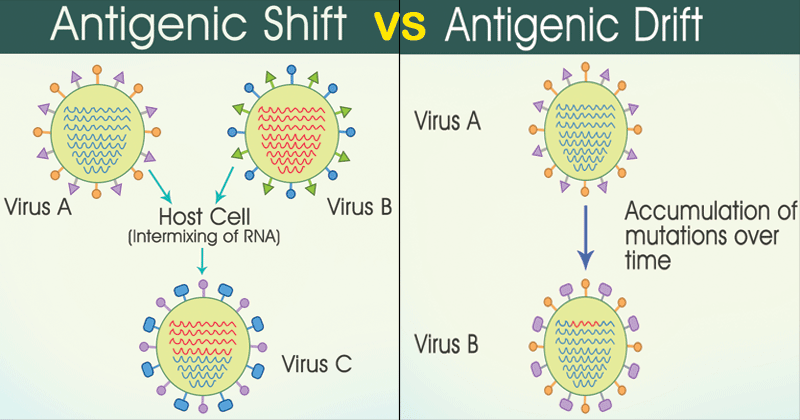
Interesting Science Videos
Here are some differences:
| S.N. | Characteristics | Antigenic Shift | Antigenic Drift |
| 1. | Definition | Antigenic shift refers to the gene recombination occurring when influenza viruses re-assort. | Mutations causing minute changes in the hemagglutinin and neuraminidase antigens on the surface of the Influenza virus is termed antigenic drift. |
| 2. | Result in | Forms a new sub-type (Subtype A + Subtype B –> New Subtype). | Forms a new strain of the virus. |
| 3. | Genome changes | Large change in nucleotides of RNA. | Small mutation of RNA. |
| 4. | Results from | Genome re-assortment between different subtypes. | Accumulation of point mutations in the gene. |
| 5. | Change type | The change is sudden and drastic. | The change is gradual. |
| 6. | Virus involved | One or more viruses are involved. | Only one virus is involved. |
| 7. | Magnitude of change | The change is large at once. | Changes increase with each division cycle. |
| 8. | Relatedness of new virus | The new form or subtype produced bears no similarity to the previous virus. | The strains produced by antigenic drift are somewhat similar to the older strains. |
| 9. | Host range | May jump from one species to another, for instance, animal to human. | May infect animals of the same species only. |
| 10. | Frequency of occurrence | Occurs once in a time. | Occurs frequently. |
| 11. | Antigen changes | The virus acquires completely new antigens—for example by reassortment between avian strains and human strains. | Antigens are only mutated. |
| 12. | Virus type involved | Occurs only in Influenza Virus A | Occurs in Influenza Virus A, B, and C |
| 13. | Leads to | Leads to pandemics. | Leads to main epidemics. |
| 14. | Treatment option | Difficult to treat (need new vaccine) | Easy to treat (antibody and drugs available) |
| 15. | Susceptibility | Everybody is susceptible to the virus after an antigenic shift, and novel influenza may thus spread uncontrollably. | Some people may still be immune and some others may be partially immune to the new strain of virus thus leading to a milder illness. |
| 16. | Examples | The 1968 pandemic arose when the H3 hemagglutinin gene and one other internal gene from an avian donor reassorted with the N2 neuraminidase and five other genes from the H2N2 human strain that had been in circulation.
The 1918 pandemic arose when an avian H1N1 strain mutated to enable its rapid and efficient transfer from human to human. |
The subtle mutations accumulated through antigenic drift of these subtypes (e.g., H1N1, H3N2, H5N1) give rise to different strains of each subtype.
Antigenic drift is also known to occur in HIV (human immunodeficiency virus), which causes AIDS, and in certain rhinoviruses, which cause common colds in humans. It also has been suspected to occur in some cancer-causing viruses in humans. |
Read more about Antigenic Shift and Antigenic Drift from USMLE Step 1 Preparation videos and books.
References
- http://score99.blogspot.com/2009/05/influenza-antigenic-drift-and-shift.html
- http://www.usmleforum.com/files/forum/2009/1/470125.php
- https://microbiologyinfo.com/differences-between-antigenic-shift-and-antigenic-drift/
- https://www.globalsecurity.org/security/ops/hsc-scen-3_flu-antigenic.htm
- Lydyard, P.M., Whelan,A.,& Fanger,M.W. (2005).Immunology (2 ed.).London: BIOS Scientific Publishers.
